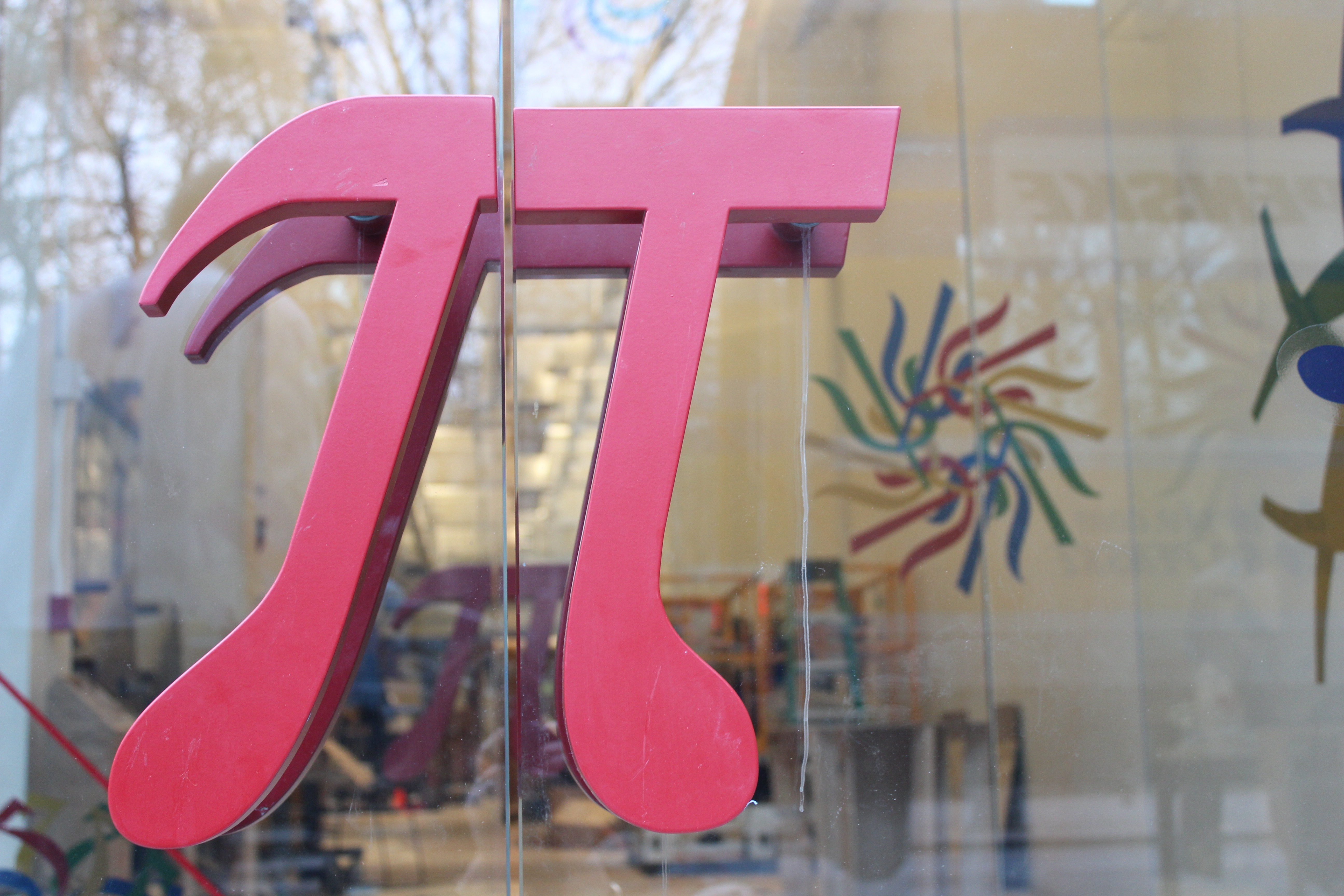
________________
________________

Math for the Ages
At the math tournament, three volunteers — a woman, her daughter, and her granddaughter — have written to the competition’s founder that their ages multiplied together equal 15,400, and the sum of their ages equals that of the competition’s founder. The founder could not determine their ages. The volunteers are each at least 16 years apart in age.
What are the ages of the volunteers and the founder?
Three Racers
The team members spend their lunch break in Madison Square Park and decide to have some 100-meter, two-person races. In the first race, Casey beats Rory by 5 meters. In the next race, Rory beats Liam by 10 meters.
If each runs at a constant speed, by how many meters will Casey beat Liam in the final race?
| Spread the word: | Tweet |
Solutions to week 104
Perfect Pairings. The best way to attack the question of whether or not there is a schedule of play for the bridge club that satisfies all of the requirements is to try to construct one. If we succeed, then we know the answer is “yes,” and if we fail repeatedly we will know to look for a reason why there can’t be such a schedule, to try to make the case for an answer of “no.”
So, let’s number the couples from 1 to 8, and label the spouses in a couple as “a” and “b,” so that the individual players are 1a, 1b, 2a, 2b, and so on. Since the couples always want to be in the same room, we only need to think about assignments of couples to rooms. Since there are eight couples and four rooms, but two couples per room per game, it is natural to start by dividing the couples into two groups of four, say 1 through 4 and 5 through 8, and asking if there is a way to assign each couple to a different room each week so that all possible pairs of couples with one from the first group and one from the second group occur. Considering just the first group of couples, assigning each couple to a different room each week creates what is called a Latin square, one example of which is:
1423
2314
3241
4132
If we have another Latin Square for couples 5 through 8 so that all possible pairs of couples occur, then those two Latin squares are called orthogonal Latin squares. Here’s one example you can look up, which includes the example for couples 1 through 4 just given:
18 46 25 37
27 35 16 48
36 28 47 15
45 17 38 26
So a good start will be to use those assignments of the couples to the rooms for two groups of four weeks, once pairing the a spouses and pairing the b spouses, and once making two a-b spouse pairs. That scheme will get every player paired with eight of the others over eight weeks, sitting in each room twice. Those circumstances satisfy exactly half of the club’s requirements.
Given that we paired the first couple with couples 5 through 8 in eight weeks, it makes sense to try pairing the first (and second) couples with couples 3 and 4 in the next four weeks, during which time couples 5 and 6 will pair with 7 and 8. In fact, we can use the same orthogonal Latin square pattern for these four weeks, simply substituting 1, 2, 5, and 6 for 1, 2, 3, and 4, and then interpreting 5, 6, 7, and 8 as 3, 4, 3 reversed, and 4 reversed when paired with 1 or 2, and interpreting them as 7, 8, 7 reversed, and 8 reversed when paired with 5 or 6. During this group of four games, every partnership plays in each room once.
Next we devote two weeks to the last remaining inter-couple partnerships: 1 with 2, 3 with 4, 5 with 6, and 7 with 8. In the first week they play with a’s/b’s matching, the second week with them swapped.
Finally, we use the first and last weeks for the couples to partner together, and to even out the number of games in each room (which are uneven from the two weeks just described).
Putting all these ideas together, a schedule which satisfies all of the requirements is
Week: 1 2 3 4 5 6 7 8 9 10 11 12 13 14 15 16
R1: 1a-1b 1a-8a 4a-6a 2a-5a 3a-7a 1a-8b 4a-6b 2a-5b 3a-7b 1a-4b 6a-8a 2a-3a 5a-7b 5a-6a 7a-8b 3a-3b
2a-2b 1b-8b 4b-6b 2b-5b 3b-7b 1b-8a 4b-6a 2b-5a 3b-7a 1b-4a 6b-8b 2b-3b 5b-7a 5b-6b 7b-8a 4a-4b
R2: 3a-3b 2a-7a 3a-5a 1a-6a 4a-8a 2a-7b 3a-5b 1a-6b 4a-8b 2a-3b 5a-7a 1a-4a 6a-8b 7a-8a 5a-6b 1a-1b
4a-4b 2b-7b 3b-5b 1b-6b 4b-8b 2b-7a 3b-5a 1b-6a 4b-8a 2b-3a 5b-7b 1b-4b 6b-8a 7b-8b 5b-6a 2a-2b
R3: 5a-5b 3a-6a 2a-8a 4a-7a 1a-5a 3a-6b 2a-8b 4a-7b 1a-5b 5a-8a 2a-4b 6a-7b 1a-3a 1a-2a 3a-4b 7a-7b
6a-6b 3b-6b 2b-8b 4b-7b 1b-5b 3b-6a 2b-8a 4b-7a 1b-5a 5b-8b 2b-4a 6b-7a 1b-3b 1b-2b 3b-4a 8a-8b
R4: 7a-7b 4a-5a 1a-7a 3a-8a 2a-6a 4a-5b 1a-7b 3a-8b 2a-6b 6a-7a 1a-3b 5a-8b 2a-4a 3a-4a 1a-2b 5a-5b
8a-8b 4b-5b 1b-7b 3b-8b 2b-6b 4b-5a 1b-7a 3b-8a 2b-6a 6b-7b 1b-3a 5b-8a 2b-4b 3b-4b 1b-2a 6a-6b
Therefore, yes it is possible for the Varsity Math team to satisfy all of the club’s requests.
X Factor. First, since there are six volunteers, and the first one writes a two on the chalkboard, and each successive volunteer writes the next counting number, by the time the last volunteer initially writes a number on the chalkboard, it has the whole numbers from one through seven inclusive written on it.
After that we have the phase in which each volunteer erases any two numbers, and writes their sum plus their product on the board in place of them. Let’s suppose the two numbers erased were a and b. Then they are replaced by ab+a+b. Examining this expression, it looks remarkably close to (a+1)(b+1) = ab+a+b+1; in fact, it is just one less. That is to say, each pair of numbers erased is replaced with one less than the product of one more than each of the numbers. When that new number is combined with a third, the same rule will produce one less than the product of one more than each of the three numbers, and so on. Since the order that numbers are multiplied doesn’t affect the result, the final number remaining on the board must be one less than the product of each of the starting numbers plus one, or 2×3×4×5×6×7×8 – 1 = 8! – 1 = 40,319.
Last week I asked why there were exactly eight choose three, or 56, ways to obtain a sum of nine when rolling four ordinary dice. It’s actually easier to solve this if you subtract one from every face of every die, so that the dice have faces marked from zero through five. Then we are asking how many ways are there to obtain a sum of five when rolling these lesser dice (since to get back to ordinary dice we add one to every face, which adds four to the sum).
Now imagine we had a row of eight dots (which we think of as copies of the dots on that dice). That’s three more than we need to make a sum of five, so imagine crossing out any three, to get a diagram that might look something like this:
• × × • × • • •
Now think of that as one pip on the red die, zero pips on the green die (because there are no pips remaining between the first and second crossed-out dots), one pip on the blue die, and three pips on the white die. In other words, whichever dots were crossed out, we can interpret the number of dots (which might be zero) before the first one crossed out as the number of pips on the red die, the number of dots between the first and second cross-out as the number on the green die, between the second and third cross-out as the blue die, and after the last one as the white die. Since we started with eight dots and crossed out three, there will be five dots left not crossed out, so the total on the dice will be five.
Similarly, from any way of arranging the dice so that the total is five, we can construct a line of eight dots with three crossed out which corresponds to it: just put the number of pips on the red die, then a crossed-out dot, then the pips on the green die, then a cross-out, then the number on the blue die, then a cross-out, and then the number from the white die. Since the total on the dice was five, there will be five dots not crossed out and three crossed out for a total of eight.
Thus, we have established that the number of ways to get a total of five on four dice marked 0-5 (and hence a total of nine on four ordinary dice) is the same as the number of ways to choose three dots to cross out from a line of eight dots, which is clearly eight choose three.
Recent Weeks
Week 104: X Factor & Perfect Pairings, solutions to Two Sums & Double-Faced
Week 103: Two Sums & Double-Faced, solutions to Zombie Epidemic & Revenge on the Zombies
Week 102: Zombie Epidemic & Revenge on the Zombies, solutions to Heads Up & Balanced Flip
Week 101: Heads Up & Balanced Flip, solutions to Average Triangle & Monotone 5
Week 100: Average Triangle & Monotone 5, solutions to Name that Card & Big Reveal
Links to all of the puzzles and solutions are on the Complete Varsity Math page.
Come back next week for answers and more puzzles.



